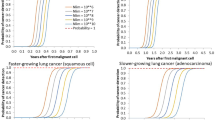Abstract
The dose-response of an individual organism can be described by a step functions if the organism survives when the dose is below a certain lethal level and dies when this level is exceeded. If, in a population of organism, the lethal dose for an individual has a unimodal distribution, the latter's properties will determine the shape of the population's response in the following manner. If the distribution is symmetric the dose-response curve has a symmetric sigmoid shape when plotted on linear coordinates. The location of the inflection point and the curve's slope around it are determined by the distribution's mode and variance. When the distribution is skewed, the dose-response curve has an asymmetric sigmoid shape which becomes reminiscent of an exponential decay when the distribution is strongly skewed to the right. The population's dose-response curve can be constructed by integration of the step changes over the distribution range. The step function representing the dose-response of an individual organism can be approximate by a Fermi function, and the distribution of an lethal doses can be represented by the Weibull distribution function. When the two functions are combined, the resulting dose-response of the populationS(X)), which is the fraction of survivors after exposure to a doseX, is given by:S(X)=∫ 10 [1/{+exp{(X-X c (φ))/a i ]}]dω whereX c (ω)={(1/b)[-ln(1-ω)]}(1/n),n andb being the constants of the Weibull distribution anda i an arbitrarily small number, i.e.a i ≪[X−X c (ϕ)], whose actual magnitude is of little significance. This model can be used to determine the underlying distributions of experimental dose-response relationship. It was applied to published survival data of microorganisms exposed to pulsed electric field, X-ray radiation and ozone to show that the different observed shapes of the dose-response curve, and shifts between them, can be expressed in terms of the correponding distribution parameters, namely the mode, variance and skewness.
Similar content being viewed by others
References
Castro, A. J., G. V. Barbosa-Canovas and B. G. Swanson. 1993. Microbial inactivation of foods by pulsed electric fields.J. Food Proc. Preserv. 17, 47–73.
Clark, D. S. and J. Takacs. 1980. Ozone. InMicrobial Ecology of Foods. Vol. I. Factors Affecting Life and Death of Microorganisms, Publication of the International Commission on Microbial Specification or Foods, p. 191. New York: Academic Press.
Everitt, B. S. and D. J. Hand. 1981.Finite Mixture Distributions. London: Chapman and Hall.
Ingram M. and T. A. Roberts. 1980. Effect of ionizing radiation on microorganisms. InMicrobial Ecology of Foods. Vol. I. Factors Effecting Life and Deth of Microorganisms Publication of the International Commission on Microbial Specifications for Foods, p. 191. New York: Academic Press.
McMeekin, T. A., J. N. Olley, T. Ross and D. A. Ratkowsky. 1993.Predictive Microbiology. Theory and Application. New York: Wiley.
Patel, J. K., C. H. Kapadia and D. B. Owen. 1976.Handbook of Statistical Distributions. New York: Marcel Dekker.
Peleg, M. 1995. A model of microbial surviva after exposure to pulsed electrics fields.J. Sci. Food Agric. 67, 93–99.
Peleg, M. 1996. Evaluation of the Fermi equation as a model of dose-response curves.Appl. Microbiol. Biotechnol. 46, 303–306.
Seaborg, G. T. and W. D. Loveland. 1990.The Elements Beyond Uranium. New York: Wiley.
Teixeira, A. 1992. Thermal processing calculations. InHandbook of Food Engineering, D. R. Heldman and L. B. Lund (Eds), pp. 563–571. New York: Marcel Decker.
Whiting, R. C. 1995. Microbial modeling in foods.Crit. Rev. Food Sci. Nut. 35, 467–494.
Author information
Authors and Affiliations
Rights and permissions
About this article
Cite this article
Peleg, M., Normand, M.D. & Damrau, E. Mathematical interpretation of dose-response curves. Bltn Mathcal Biology 59, 747–761 (1997). https://doi.org/10.1007/BF02458428
Received:
Revised:
Issue Date:
DOI: https://doi.org/10.1007/BF02458428




